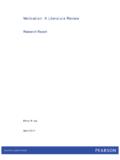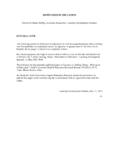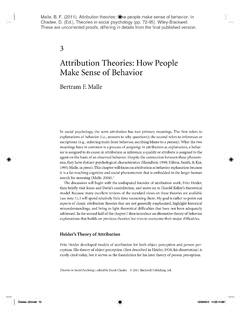Transcription of Motivation and Classroom Learning
1 - 1 Chapter 7 Motivation andClassroom LearningThis chapter will help you answer the following questions about your learners: How can I help my learners interpret their Classroom setbacks in ways that elicitrenewed effort? What are some things teachers say to learners that can lower their Motivation tosucceed? How can Learning strategies improve my students Motivation to learn? How can I convey to my students the Motivation to say Yes, I can do what myteacher expects ? How can I enhance my learners determination to learn what I teach? How can I use project-based Learning to motivate my learners?In this chapter you will also learn the meanings of these terms:antecedentsattribution theorycausal schematadeficiency/growth needs - 2drive theoryinstinct theoryintrinsic motivationlocus of causalityproject-based learningself-determination theoryself-efficacy theorysituational cuesBehavioral and cognitive psychologists agree that Motivation is essential forlearning.
2 Yet how to motivate learners in the Classroom continues to be one of themost puzzling problems confronting the teacher. Let s look in on ProfessorThomas s Learning seminar as his students discuss the topic of : Well, it seems to me that Motivation is becoming the scapegoat forall Learning failures. That s all I hear at school .. These kids just aren tmotivated or This kid just hasn t any Motivation . And all the otherteachers nod as if something profound has been : I don t understand your problem with that. I say the same thingevery day after my fourth-period class. Those kids just aren t motivated!Betty: What gets to me is that I hear teachers talking about Motivation as ifthey haven t any responsibility for it, or they believe it s : I agree. We have to look at Motivation as something affected by whatwe do and not as something out of our Thomas: So you agree with the behavioral science tradition onmotivation?
3 Kyle: To the extent that it says a learner s Motivation is under our control,yes. But the behaviorists view Motivation as something we impose on - 3person through reinforcement and, if necessary, punishment. I see it asmore : So you think it s all inside the : Not in the sense that we re born with it. To me Motivation is how achild thinks about goals, and about his ability to reach them. As teachers,we can influence : But that makes Motivation sound so cold and mechanistic. Motivatedpeople have a kind of energy that seems to come from inside isn t just knowing where you want to go and believing you cando it. It s also having the power and vigor to get Thomas: Is this something a teacher can give a learner? And ifso, how?Is Motivation an inherited trait like one of the three temperaments (activity,adaptability, emotionality) that we discussed in Chapter 3? Or is motivationinfluenced by reinforcement and consequences that strengthen some behaviors andweaken others?
4 Is the key to motivating learners a lesson plan that captures theirinterest and attention? In other words, is Motivation something innate that we areborn with that can be strengthened by reinforcers external to the Learning task, oris it something interwoven with the Learning process itself? In Chapter 4 westudied how behavior can be created and strengthened by reinforcers external tothe Learning task. In this chapter we will focus our attention on Motivation influences learners to choose a task, get energized aboutit, and persist until they accomplish it successfully, regardless of whether it bringsan immediate reward. Intrinsic Motivation is present when learners actively seekout and participate in activities without having to be rewarded by materials oractivities outside the Learning task. The first-grader who practices - 4because she likes to see neat, legible letters like those displayed on the letter chartis intrinsically motivated.
5 The fourth-grader who puts together puzzles of statesand countries because she likes to see the finished product and wants to learn thenames of the capital cities is intrinsically motivated. The ninth-grader who repeatstyping drills because he likes the feel of his fingers hopping across the keys, andconnects that sense with the sight of correctly spelled words on the page, hasintrinsic this chapter we will present a framework for understanding intrinsicmotivation and then link this framework to Classroom strategies for building , we will describe some early motivational theories that make use of theperson-as-machine metaphor. Not all of these theories apply to the Classroom , butlearning about them will show you how different theorists have approached theproblem of Motivation . You are sure to find some elements of your own thinkingabout Motivation in each of we will examine the current cognitive approaches, which view motivationfrom the vantage point of the person-as-rational-thinker metaphor.
6 Cognitivemotivation theories share strong ties with cognitive Learning theories. We willexamine two cognitive Motivation theories, attribution theory and self-efficacytheory. Both emphasize that learners need to know, understand, and appreciatewhat they are doing in order to become motivated. Then, along with thesecognitive Motivation theories, we will examine a motivational perspective calledself-determination theory, which attempts to reconcile cognitive theory s emphasison intrinsic Motivation with more traditional notions of human needs and , in the last section of this chapter, you will learn to use an approach toteaching and Learning called project-based Learning , which employs the principlesof intrinsic Motivation to energize - 5 Before we begin, consider the two most obvious features of the behavior ofmotivated learners: energy and determination. Motivated learners have more thanjust a vision of a goal they want to achieve.
7 They have a passion or interest forachieving that goal. Motivated learners initiate actions, expend effort, and persistin that effort. As you become acquainted with the various theories, think abouthow they apply to your learners and keep this question in mind: How can thistheory account for the energy and direction of a motivated learner?Person-as-Machine: Biobehavioral Motivation TheoriesTeacher: Now Jared, do you see why we have to do this stuff?Jared: It s boring. I really don t care about all this stuff!Teacher: Jared, do you care about passing this course?Jared: Is that a threat?Teacher: Jared, when I was in high school, I had a teacher who said thereare only two things in life that are : School is one of them, right?Teacher: No, death and taxes. You gotta die and you gotta pay else is : So you mean I don t have to do this stuff?Teacher: You don t have to do this stuff. You don t have to read the paperand know what s going on in the world.
8 You don t have to graduate fromhigh school. You don t have to get a : : I ll be happy to help you if you want : I get it. I ll do it! (Adapted from Nehring, 1989, pp. 39 40)How to win the hearts and minds of learners has been a concern of educationalpsychologists since the foundation of their science. In any given Classroom , - 6learners will participate enthusiastically while others will not, but the explanationfor this disparity is not always apparent. Over the years educational psychologistshave used the term Motivation to account for variations in the energy anddirection of learners behavior. But as we will see, Motivation means verydifferent things to different no one has ever seen, touched, or weighed Motivation , educationalpsychologists typically use metaphors to help them describe this phenomenon. Theuse of metaphors to describe complicated mental phenomena is familiar to youfrom earlier chapters of this book: Piaget uses the balance metaphor to helpexplain cognitive development, and cognitive psychologists use the metaphor ofthe mind as an information processing system.
9 Likewise, various other metaphorshave been the principal source of Motivation theory and research (Weiner, 1991).The earliest theories of Motivation assumed that the forces that give energy anddirection to human behavior were beyond human control. These theories proposethat either internal or external forces beyond our control cause people to displaymotivated or unmotivated behavior. Weiner (1991) proposes person-as-machine as a metaphor for describing these to Weiner, the person-as-machine metaphor has the followingattributes: Machines have parts (a structure). There is a desired end or function. The whole functions as a unit of mutually interacting parts to reach thisend. The behaviors are involuntary, or without volition. Hence, the actions arelike reflexes. The behaviors are performed without conscious - 7 The reactions are necessary or predetermined by a set of circumstances oractivating stimuli.
10 The actions are fixed and routine. Forces and energy are transmitted. The forces may be in balance orequilibrium (no tendency to change), or out of balance, promoting atendency toward change. (Weiner, 1991, p. 922)By categorizing certain theories of Motivation under the person-as-machinemetaphor, Weiner alerts us to various distinctive characteristics pertaining tohuman Motivation . The theories that make use of this metaphor include instincttheory, drive theory, and deficiency-growth needs theory (Zimbardo, 1996). Let slook at what each of these theories has to say about TheoryInstinct theory was the earliest theory of Motivation . Instincts are inherited,unlearned forces that help all species survive. Animals like salmon, bears, andturtles are preprogrammed at birth to engage in specific instinctive reproductiveand feeding patterns. For example, salmon instinctively return to the same streamin which they were spawned to lay their are also born with instincts.









